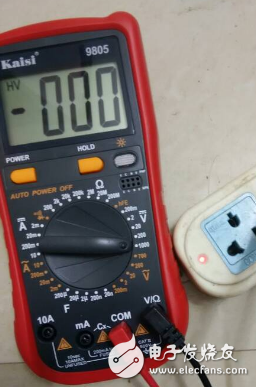How to use a megohmmeter to check if a circuit is grounded, the first step is always to measure the voltage to ensure it's safe and free of electricity before performing any other measurements. If you're dealing with a capacitor or a capacitive device, make sure to discharge it first, then confirm that there is no voltage present. After that, set your multimeter to the 2000 megohm range. One test lead should be connected to the grounding point or the metal casing of the equipment, while the other should touch a live conductor. If the resistance is less than 0.5 megohms, it indicates a ground fault. Typically, a leakage protector rated above 0.5 megohms and 30 mA won’t trip, so the circuit is considered safe. However, this can vary depending on the operating voltage and specific technical requirements.

In daily life, there are many types of circuits—such as electronic circuits, power lines, motor circuits, etc.—and it's important to know which one you're working with. Let's take three common examples and explain how to use a multimeter for grounding checks.
**First, in an electronic circuit**, under normal conditions, the multimeter should be set to the highest range, typically 10k ohms. At this setting, the measured resistance will be close to 10k ohms, and the needle may slightly move. Then adjust the test leads. Some instruments might show slight differences after adjustment, but this is normal. In electronic circuits, high-frequency capacitors are often grounded to reduce interference, so a small resistance reading to ground is expected. This is why people might feel a tingling sensation. It's important to note that using a megohmmeter (shaker) on such circuits could damage sensitive components.
**Second, for a voltage transmission circuit**, like a household lighting circuit, always turn off the main switch and all appliance switches before measuring. To check grounding, use the multimeter to measure the resistance between the live wire and ground. Ideally, the resistance of the neutral line should be infinite. Measuring at 2 megohms isn't sufficient because the multimeter's battery only provides 9 volts, while the actual line voltage is around 220 volts. For better accuracy, a 500-volt megohmmeter is recommended. The measured resistance should be greater than 0.5 megohms to ensure the circuit is not leaking.
**Third, for a motor circuit**, a multimeter isn't suitable for accurate grounding tests. Instead, use a 500-volt megohmmeter. The resistance of the coil to ground should be over 0.5 megohms for safety. For new motors, the insulation resistance should be above 10 megohms. Different circuits have different grounding requirements, and higher voltage systems require higher insulation resistance to the ground. Always follow the manufacturer’s guidelines and local electrical standards when testing.
Floor Standing Digital Signage
Floor Standing Digital Signage,Touch Digital Signage,Lcd Signage Indoor,Digital Signage Menu
Guangdong Elieken Electronic Technology Co.,Ltd. , https://www.elieken.com
